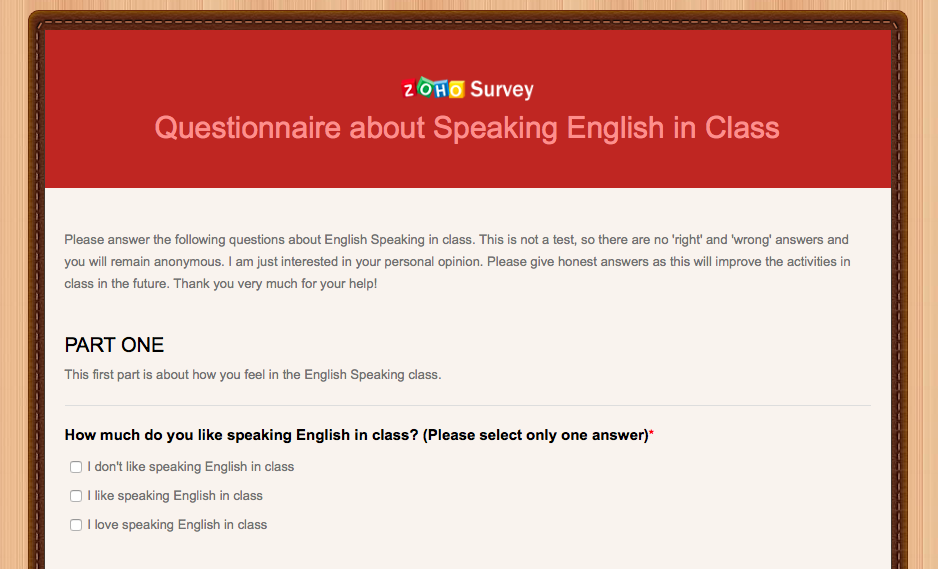
Background
Reflecting on my experience this academic year, what really stands out is how reticent my students were, in my Spoken English class, at speaking English. I had four classes with approximately 20-24 students, aged 18-19 years old in each class. Two classes were “Freshmen”, the equivalent of first year university students. Two classes were “Sophomores”, the equivalent of second year university students. They all either study Accounting or Business Management, with overlap in terms of modules taken. One of their modules is English, which is split into four streams – Reading, Writing, Listening & Speaking. We met for 90 minutes twice a week. As the other three skills are practiced in other classes, the majority of activities in my class were focused on spoken production.
Research Question
In order to better understand the hesitance of my students to speak, I had previously devised a questionnaire that sought to explain what factors prevented students from fully participating in activities in class. Therefore, the following research question was defined:
What factors influence student ability to speak English in class?
Question Selection
The item pool (cited by Dörnyei & Csizér, 2012:77) of questions is drawn from informal observations of the participation of my students in class. I also borrowed questions from three* other sources, as advised by Dörnyei & Csizér (p77).
According to my visual observations, the factors that may contribute to my student’s desire to speak in class related to:
the perception of their own speaking ability
the perception of other student’s ability
type of preparation work
time for preparation
nature of speaking activity
teacher’s instructions
teacher’s feedback
Therefore, my fifteen questions were set to compare and contrast my initial perceptions of class activity with the reported perceptions and actions of my students. I closely adhered to Dörnyei & Csizér’s five key strategies for producing questions that work (2012: 78), which coincides with the ‘tips’ given by the University of Washington Office of Educational Assessment (2006). The survey format remains within the four ‘full’ page limit, and does not exceed the 30-minute completion limit suggested by Dörnyei & Csizér (2012: 78). A mix of scales and items, including the Likert Scale and open-ended questions provide a balanced survey, with personal questions appended in the final section. Finally, although it is believed that “the quality of the obtained data improves if the questionnaire is presented in the respondent’s own mother tongue” (Dörnyei & Csizér, 2012: 79), a translation for my native Chinese students was beyond the remit of the assignment for which this questionnaire was produced.
The questionnaire can be found here: https://survey.zohopublic.com/zs/YmywmI
It is hoped that the work carried out in preparing this questionnaire will be of value for the questionnaire/survey and/or interviews I plan to organise for my upcoming Masters dissertation project.
As always, comments are warmly welcome.
References
DeVellis, R.F. (2003). Scale development: Theory and applications (2nd ed.). Thousand Oaks, CA: Sage. Cited in Dörnyei, Z., Csizér, K. (2012), How to Design and Analyze Surveys in Second Language Acquisition Research. In Mackey, A., Gass, S.M. (2012) Research Methods in Second Language Acquisition.
Dörnyei, Z., Csizér, K. (2012), How to Design and Analyze Surveys in Second Language Acquisition Research. In Mackey, A., Gass, S.M. (2012) Research Methods in Second Language Acquisition.
Tips for Writing Questionnaire Items, University of Washington Office of Educational Assessment (2006)
https://www.washington.edu/oea/pdfs/reports/OEA_QuestionnaireTips.pdf
Accessed 6th November 2015
Borrowed Questionnaire Sources*
Farmer, R. & Sweeney, E. (1997). Are you speaking comfortably? In D. Kember, B. H. Lam, L. Yan, J. C. K.Yum & S. B. Liu (Eds.) Case Studies of Improving Teaching and Learning from the Action Learning Project (pp. 347-356). Hong Kong: Action Learning Project.
http://teaching.polyu.edu.hk/datafiles/R5.pdf
Accessed 6th November 2015
Kormos, J., & Csizér, K (2008). Age-related differences in the motivation of learning English as a foreign language: Attitudes, selves and motivated learning behaviour. Language Learning, 58, 327-355. Cited in Dörnyei, Z., Csizér, K. (2012), How to Design and Analyze Surveys in Second Language Acquisition Research. In Mackey, A., Gass, S.M. (2012) Research Methods in Second Language Acquisition.
Osboe, S., Fujimura, T. & Hirschel,. R. (2007) Student Confidence and Anxiety in L2 Speaking Activities. Independent Learning Association.
http://www.independentlearning.org/uploads/100836/ILA2007_032.pdf
Accessed 6th November 2015

interesting
Thanks, Bahiru.
Hi, good day Miss Karinawp. I really find your questionnaire useful for my research paper. Is it possible for me to use it?
Hi Nelkhin,
Thank you for your message.
And sorry about the late reply.
Yes, you can use it.
Karina
Hi, good day Miss Karinawp. I really find you’re questionnaire useful for my research paper. Is it possible for me to use it?